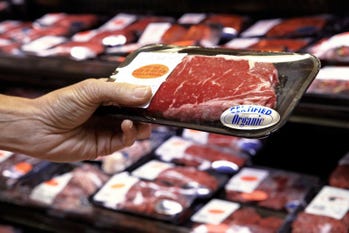Guidelines meat realityGuidelines meat reality
The U.S. dietary guidelines came out the same week that country-of-origin labeling requirements ended for meat, but big food may be setting itself up for a stumble.

It’s an odd week when big food stumbles over its own greed.
That’s still overstating the situation, but a convergence of policy and legislation suggests the mechanism of unintended consequence may be in play as a pair of headlines arcing across nutrition and industrial food production hit the newsstands in the same week.
Thursday’s headline concerned the official unveiling of the U.S. dietary guidelines. They’ve been in the works for years, and under not-surprising debate for months (the idea of sustainability got yanked out in the fall, but the sugar lobby isn’t smiling).
Earlier in the week, a different headline told consumers that country of origin labeling (COOL) for meat is no longer required. It’s not “Where’s the beef?” It’s “Where’s the beef from?”
Here’s where greed gets clumsy. Part of the fight over the guidelines to take out sustainability was about keeping meat in. So now meat gets to keep its space on the plate, but consumers don’t get to know where it came from. Whether country of origin matters more in the abstract than it does in the aisle is an unknown, but information like that isn’t always crucial until it becomes critical. The mad cow madness of the early '90s is coming up on a generation ago, but the world is never short for food-borne pathogens.
critical. The mad cow madness of the early '90s is coming up on a generation ago, but the world is never short for food-borne pathogens.
It might not take much of a scare to have shoppers walking by the bus-sized meat case at the mass market grocery store and ready to look past the higher prices in the natural and organic sections expanding across every Kroger, Safeway and Super Target in the country. They might like the taste and keep shopping in that corner longer after the crisis has passed. That kind of quality wasn’t so easily accessible during the mad cow years.
When people pay more for meat, they will likely eat less of it. That’s the goal for many healthy eating advocates, people less than thrilled by the new guidelines—eat less meat, and when you do eat meat, make sure the quality is there.
Most people won’t notice how the U.S. dietary guidelines affect what goes in their shopping carts or plops onto their kid’s school cafeteria plate. There are farm subsidies and rules on what commodities get favored in federal nutrition programs. But mystery meat, even when it’s not that mysterious, draws a universal cringe. Consumers demanding increasing transparency aren’t going to appreciate industry taking steps that blur the picture of where their food came from, especially not with meat, the most truly visceral of foods.
About the Author
You May Also Like





